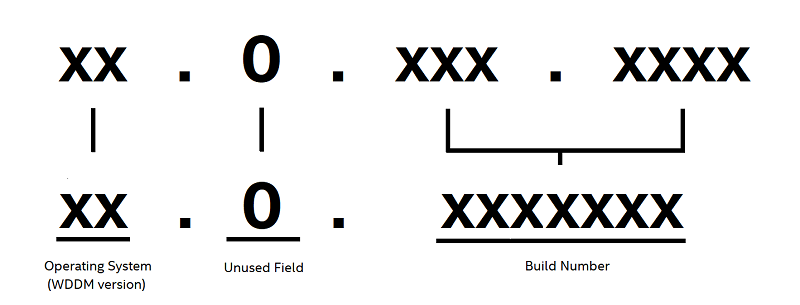100 & Newer Drivers
The Intel® Graphics Driver version schema used in Download Center has changed to provide better scaling and support for our driver build process, and at the same time match the new driver naming convention used in Windows*. This schema is as follows:

To determine if you have the latest drivers installed, always compare the entire build number (seven digits) of the driver installed on your computer with the entire build number (seven digits) of the latest driver available for download.
The seven digit build number is created by combining the numbers from the last two sections. For example, the build number for 30.0.101.2031 is 1012031. The build number for 27.20.100.9466 is 1009466. Comparing these two numbers shows that 101.2031 is a more recent driver than 100.9466.
| Note | If you see the number 20 instead of 0 in the second field of the driver number, this means that the highest supported DirectX* version is 12.1. This also signifies the driver is using a previous Microsoft naming convention for WDDM 2.7 and lower, as noted in the identifier table below. This field is set to 0 with the driver naming convention introduced by Microsoft with Windows® 10 May 2021 Update (21H2) and later. This is so it can be used for other purposes in the future. |
The following table provides details on the first identifier that makes the current driver schema:
| Identifier | Operating System (WDDM version) |
| 32 | Windows 11* - WDDM 3.2 |
| 31 | Windows 11* - WDDM 3.1 |
| 30 | Windows 11* - WDDM 3.0 |
| 27 | Windows® 10 May 2020 Update - WDDM 2.7 |
| 26 | Windows® 10 May 2019 Update - WDDM 2.6 |
| 25 | Windows® 10 October 2018 Update - WDDM 2.5 |
| 24 | Windows® 10 April 2018 Update - WDDM 2.4 |
| 23 | Windows® 10 Fall Creators Update - WDDM 2.3 |
| 22 | Windows® 10 Creators Update - WDDM 2.2 |
| 21 | Windows® 10 Anniversary Update - WDDM 2.1 |
| 20 | Windows® 10 - WDDM 2.0 |
| 10 | Windows 8.1* - WDDM 1.3 |
| 9 | Windows 8* - WDDM 1.2 |
| 8 | Windows 7* - WDDM 1.1 |
| Notes |
|
15.45 & Older Drivers
Download Center also hosts older graphics drivers that use a naming schema to define driver versions that may not match 1-to-1 the operating system's own driver convention as detailed in the previous tables. These older drivers are also known as legacy drivers. The schema is as follows:

Driver Baseline: Differentiates different generic driver packages and is often assigned based on the supported platforms and operating systems.
Release Revision: Used internally during the driver development cycle.
Build number: Last four digits indicate the actual driver number.
The table below provides details on platform and operating system compatibility for these drivers.
| Driver Baseline | Platform compatibility | Operating System 32-bit support | Operating System 64-bit support |
| 15.45 | 6th Generation processors | Windows 7* | Windows 8.1* Windows 7* |
| 15.40 | 5th Generation processors | Windows 8.1* Windows 7* | Windows® 10 Windows 8.1* Windows 7* |
| 4th Generation processors | Windows® 10 | Windows® 10 | |
| Braswell platform | Windows® 10 Windows 8.1* Windows 7* | Windows® 10 Windows 8.1* Windows 7* | |
| Cherry Trail platform | |||
| 15.36 | 4th Generation processors | Windows 8.1* Windows 7* | Windows 8.1* Windows 7* |
| 15.33 | 3rd Generation processors | Windows® 10 Windows 8.1* Windows 7* | Windows® 10 Windows 8.1* Windows 7* |
| Bay Trail platform |
The table below provides examples on how to map the graphics driver version shown in Windows* to the Intel driver release shown in Download Center. The 3rd field in the driver version reported by Windows* most closely maps to the baseline in the Intel release version. The following can be used to translate:
| Release Version (Intel) | Driver Version (Windows*) | Mapping |
| 15.33.53.5161 | 10.18.10.5161 | 15.33 -> 10 |
| 15.36.41.5180 | 10.18.14.5180 | 15.36 -> 14 |
| 15.40.48.5171 | 20.19.15.5171 | 15.40 -> 15 |
| 15.45.34.5174 | 21.20.16.5174 | 15.45 -> 16 |